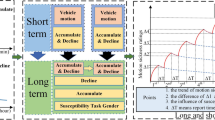Summary
Thirty-eight normal volunteers were tested in an ambulance car while being accelerated in one of the following positions: (1) sitting upright facing forward in the car, (2) lying supine on a stretcher head forward, (3) supine position head backward. Consecutive short periods of negative horizontal acceleration (0.7–0.95 g) were achieved by brisk braking manoeuvres of the car, followed by weak reacceleration (0.15 g). Motion sickness symptoms were observed and recorded after each experiment using a special motion sickness scaling index which was weighted according to the strength of any particular symptom. The results indicate that horizontal linear acceleration in a car, such as experienced during multiple braking manoeuvres, is an effective motion sickness provoking stimulus. Negative X-axis stimulation is more nauseogenic then acceleration in the Z-axis stimulation is more nauseogenic then acceleration in the Z-axis of the body.
Similar content being viewed by others
References
von Baumgarten R, Thümler R, Vogel H (1980) Experimentelle Untersuchungen über die Wirksamkeit von Metaclopramid bei Kinetose. Therapiewoche 30: 5974–5981
von Baumgarten R, Baldrighi G, Vogel H, Thümler R (1980) Physiological response to hyper- and hypogravity during rollercoaster flight. Aviat Space Environ Med 51: 145–154
Benson AJ, Bodin MA (1966) Interaction of linear and angular accelerations on vestibular receptors in man. Aerospace Med 37: 144–153
Benson AJ, Bodin MA (1966) Effects of orientation to the gravitational vertical on nystagmus following rotation about a horizontal axis. Acta Otolaryngol (Stockh) 61: 517–526
Correia MJ, Guedry FE (1967) Modification of vestibular response as a function of rate of rotation about earth-horizontal axis. Acta Otolaryngol (Stockh) 62: 297–308
Braybiel A, Wood CD, Miller EF, Cramer DB (1968) Diagnostic criteria for grading the severity of acute motion sickness. Aerospace Med 39: 453–455
Guedry FE (1963) Labyrinthine function related to experiments on the parallel swing. NSAM-874. NASA order No. R93
Guedry FE (1965) Orientation of the rotation-axis relative to gravity: It's influence on nystagmus and the sensation of rotation. Acta Otolaryngol (Stockh) 60: 30
Guedry FE (1966) Influence of linear and angular accelerations on nystagmus. 2nd Symposium on the Role of the Vestibular Organs in Space Exploration. Moffet Field, CA, USA, Ames Research Center, NASA SP-115, January 25–27
Miller EF, Graybiel A (1970) A provocative test for grading susceptibility to motion sickness, yielding a single numerical score. Acta Otolaryngol (Stockh) 274: 9–20
Money KE (1970) Motion sickness. Physiol Rev 50: 1–39
Money KE (1974) Measurement of susceptibility to motion sickness. AGARD Advisory group for Aerospace Research and Development. AGARD Conference reprint No 109: B 2-1–B 2-4
Niven JI, Hixon WC, Correia MJ (1965) Elicitation of horizontal nystagmus by periodic linear acceleration. Pensacola, Florida: Naval Aerospace
Reason JT, Brand JJ (1975) Motion sickness. Academic Press, London
Scherer H (1975) Reisekrankheit. Physiologische Reaktionen auf unphysiologische BeschleunigungsvorgÄnge. Dtsch Ärzteblatt 29: 2111–2114
Tyler DB (1946) The influence of placebo, body position and medication on motion sickness. Am J Physiol 146: 458–466
Author information
Authors and Affiliations
Rights and permissions
About this article
Cite this article
Vogel, H., Kohlhaas, R. & von Baumgarten, R.J. Dependence of motion sickness in automobiles on the direction of linear acceleration. Europ. J. Appl. Physiol. 48, 399–405 (1982). https://doi.org/10.1007/BF00430230
Accepted:
Issue Date:
DOI: https://doi.org/10.1007/BF00430230




